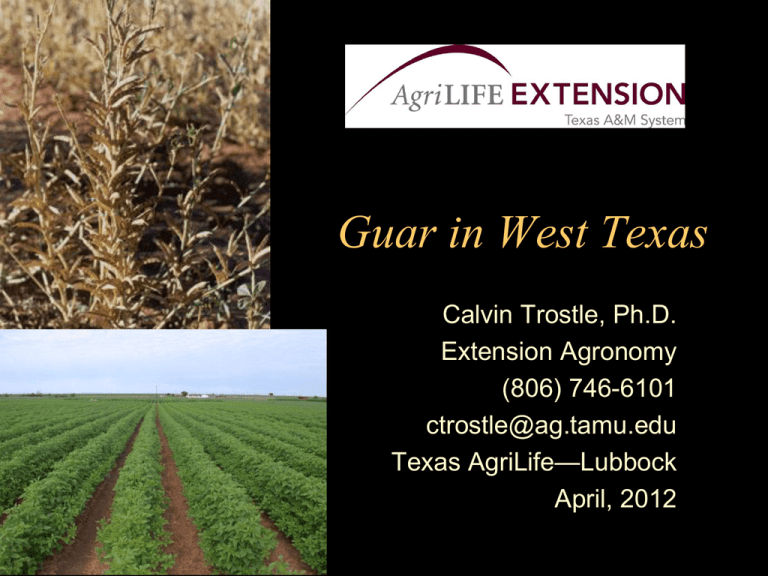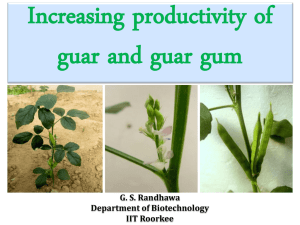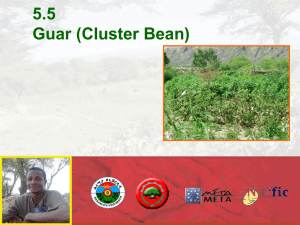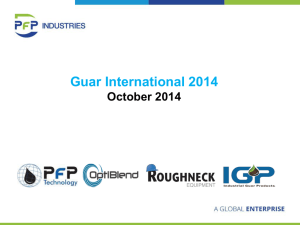Guar in West Texas
advertisement

Guar in West Texas Calvin Trostle, Ph.D. Extension Agronomy (806) 746-6101 ctrostle@ag.tamu.edu Texas AgriLife—Lubbock April, 2012 A Few Thoughts • Guar gum is highly valuable and sought after as an ingredient from small quantities in numerous food products to large scale uses in oil field services (e.g., a component of fracking fluids) A Few Thoughts • Uses range from a company needing a few tons to make tens of thousands of tons of food ingredients or finished food products, to an industry estimate of as much as 20,000 lbs. of guar gum to frac one oil well. – Can enough guar be produced for the oilfield industry? One fracking job could require 80 acres of guar production (750 lbs./A) Guar Economics • Guar is a crop that has minimal input costs to grow. Therefore the gross returns (which seem low), must be evaluated in light of actual (low) production costs. • Guar is not a crop of choice if you as a producer must service a high debt load. • Guar production budgets @ http://southplainsprofit.tamu.edu Guar Markets • Much of the guar consumed in the U.S. is imported from India and Pakistan as ‘splits’—the endosperm (which contains the valuable gum); the seed coat and embryo has been removed. • Rhodia, Inc., Vernon, TX no longer buys U.S. production, but imports splits from which gum is extracted Guar Markets • International market for guar and guar gum drives you nuts! There is no rhyme or reason to pricing or availability. Probably a manipulated market. • Some companies agree that the gum quality of imported guar is better than U.S. production – Texas Tech Univ. research suggest quality can be comparable Guar Markets • U.S. companies are wanting stable supply, and appear more willing to pay the needed cost. • Due to volatility in the international market (which is controlled and doe not necessarily reflect market conditions), interest rises in investing/establishing U.S. production when prices are high West Texas Guar, Brownfield, TX • Operating since 1999 • Installed equipment to produce guar powder (gum) in 2009 – Can’t produce enough to meet demand; also can process organic guar gum • Frequently contacted by companies wanting guar gum, but WTG goal is to establish stable longterm supply rather than try to contract large acreages for a limited time, to meet oilfield service needs. West Texas Guar, Brownfield, TX • Delivery to Brownfield • Contracted production in past five years is about 10,000 to 30,000 acres • 2012 price is the highest ever, $0.35/lb. for standard grade #1 • (806) 637-4662, http://www.westtexasguar.com Key Guar Considerations • Indeterminant, annual legume • Good for rotations with cotton, sorghum, etc. (1970’s at Texas AgriLife—Vernon: 15% lint yield increase the following year) • As drought tolerant—if not more—than any other crop in Texas (sesame would be similar) • Low risk Yield Potential • Dryland: 400-1,100 lbs./A – Getting an initial stand is important; once the stand is established then guar is highly likely to make a crop even in drought years • Limited irrigation (3-6”): 800-1,400 lbs./A • Full irrigation? Not recommended – Guar’s relative performance to other crops is best in dryland settings, especially when droughty as long as the crop is established, but guar cannot take advantage of irrigation as well as numerous other crops. • WTG yield goals ~700 lbs./A dryland; ~1,300 lbs./A irrigated Where is Guar Best Suited? • Grows adequately under a wide range of soil conditions – Clayey soils are not recommended • Performs best on medium- and sandy textured soils • Dryland pivot corners • Fields without heavy weed pressure • Humid environments are not desirable • Alternaria, bacterial blight, other diseases begin to take their toll Herbicide • • • • ~1.0 to 1.5 pint/A for trifluralin (Treflan) Select 2EC for post-emerge grass control Gowan’s ‘Sandea’ for some broadleaves Watch out if relisting cotton ground after hailout • Texas AgriLife has submitted info. for 2,4DB approval to IR-4 specialty crop program for possible labeling Guar • With sesame, the most drought tolerant crop on South Plains • Low input crop • No insects or disease treated in production since ~1998 • Target planting date: mid-May to about July 1 Dryland Guar Yields AGCARES, 2001-2002 • Dry years, but deep moisture available • Kinman and Lewis yields (averaged)-– 2001: 549 lbs./A – 2002: 829 lbs./A • Kinman & Lewis gross returns (Brownfield) & net over variable costs (averaged): – 2001: $78/A, net over variable $24/A – 2002: $104/A, net over variable $40/A Rhizobium Inoculation • I have the same frustration as you: poor to no nodulation • AGCARES, Dawson Co., 2001: – Guar seedbox powder – Concentrated peanut liquid Lift as advised by company (Bradyrhizobium) – Nothing! – Some ‘seed inoculants’ used in guar (e.g., Sono Ag., Plainview, TX) have Rhizobium, but may not be specific to guar Rhizobium Inoculation • AGCARES, Dawson Co., 2002 • Seedbox inoculant, planted June 28 • Temperature (4 PM): – – – – – – Air, 93 F Soil surface, 130 F Seed depth, 1.25” deep, 104 F 2” depth, 90 F This kind of temperature in the soil surface kills the inoculum Guar seedlings are not able to emerge from deep plantings very well, are poor at breaking crusts, thus planting deep to avoid surface soil temperatures is problematic Rhizobium Inoculation • INTX Microbials was the most recent U.S. manufacturer that still had an inoculant with guar included on the label (many minor and other ‘pulse’ crops on same label). • N-Dure? Seedbox powders historically are poor at nodulation, however, effectiveness is increased if the seed is moistened (a sugar-based soft drink, even water helps) before applying the powder. • Likely $1-2/acre for inoculant at 5 lbs. of seed/A Rhizobium Nodules on Guar Seeding • ~5 lbs./A dryland, ~8 lbs./A irrigated; higher seeding rates may increase node length, like in soybean, and ease harvest – Old TX Rolling Plains research suggested that 2 to 10 lbs./A produced no difference in yield • Listed ground, 4-8” tall beds, can help harvest • 70 degrees Fahrenheit for optimum establishment at planting – This is about as warm a soil as needed for any crop 1999 Dryland Terry Co. N Trial Treatment “Early” Low Date N Rate Avg Yield Applied (lbs./A) (lbs./A) 7/26 27 1042 A “Early” High 7/26 44 1038 A “Late” High 8/4 45 1013 A “Late” Low 8/4 22 979 A Check --- --- 898 A Alpha = 0.10; means followed by same letter are not significantly different. 1999 Irrigated Terry Co. N Trial Treatment “Early” Low Check Date N Rate Avg Yield Applied (lbs./A) (lbs./A) 7/29 59 1298 A --- --- 1297 A “Early” High 7/29 104 1277 A “Late” High 8/9 88 1272 A “Late” Low 8/9 54 1238 A Alpha = 0.10; means followed by the same letter are not significantly different. Other Fertility Results • AGCARES, Dawson Co. • Two-year results on dryland guar: no measurable yield response to 30 lbs./A P2O5 • India: most common micronutrient deficiency is Zinc Insects and Disease • None treated for yet in West Texas in 19982010 • Guar midge (infects bud)--not the same insect as sorghum midge but is the alfalfa midge Insects and Disease • Of two Texas Tech variety releases in about 2005, one variety, ‘Monument’ is very susceptible to disease—not recommended – Initial testing suggested disease was bacterial blight • Alternaria is somewhat common on guar, but usually not at damaging levels, and not practical to treat Guar--Profitability ‘Keys’ • Production as a primary crop is better than as catch crop • Wait to plant until soil moisture for germination/emergence is good Guar--Profitability ‘Keys’ • Irrigation response: ~100-150 lbs./A per 1” – Caveat: 2001, Dawson Co. – Dryland corners, 1,100 lbs./A (a good year!) – Over-the-top sprinkler irrigation same as neighboring peanuts, 700 lbs./A (frequent spray irrigation) interfered with flowering, pollination, seed set, or all three – Consider drag hoses for irrigation other than initial watering to get crop up Guar--Profitability ‘Keys’ • Experienced harvesters with right headers and can increase harvestable yield considerably – Especially with air-reels, which I think are worth the added cost ($2-4/acre) with the custom harvester – Since guar has a tendency for the pods to break off at harvest (break off, not split open), the air reel blows these shattered pods into the header Air-Reel Headers Possible Harvest Aids in Guar • If guar remains in the field a long time waiting for a killing frost, plant death, and subsequent dry-down, some seed may turn black, especially if wet conditions prevail and harvest is delayed. – This reduces grade and gum quality • Use of a harvest aid (desiccant, defoliant, herbicide) can allow earlier harvest and higher quality guar gum product. Dawson Co. 2001 Guar (lbs./A) Esser Kinman Kinman Lewis Lewis Lewis S. Cruz 0 0 30 P 0 30 P 0 0 0 0 0 0 0 30 N 0 534 a 584 a 536 a 513 a 535 a 556 a 586 a #2 #1 #1 #1 #1 #1 #1 Texas Tech Univ. Guar Trials Guar Variety 2000 (lbs./A) 2001 (lbs./A) 1,085 cd 1,364 a Kinman 285 e 1,445 a Esser 715 de 1,390 a Santa Cruz 768 de 914 bc Lewis Varieties • 1980-1983, at numerous Vernon-area locations: – Lewis ~100 lbs./A more than Kinman – Lewis ~200 lbs./A more than Esser • Kinman, Lewis (less branching, more pods on main stem), Matador (Texas Tech, 2005), and Santa Cruz are most likely varieties. – All are acceptable; see contractor Seed Quality • Germination %? Maintain as high as you can get, but some guar may have germ of only ~67% after a couple of years – Long-term seed storage sees guar seed quality deteriorate to unacceptable levels after ~8 years • Guar seed must be free of morning-glory! Similar size & shape seed that can’t be cleaned out Guar--Mistakes • Planting when soil moisture conditions are poor--poor stand establishment • Guar is not for weedy ground--only three herbicides currently labeled • Need to consider harvest method prior to planting--header type will affect flat vs. bedded planting; custom combine, $25/A • Not using limited irrigation if it is available What You Said (December, 2001) • Use higher seeding rates, maybe 8 lbs./A even on dryland • Emergence in as little as 4 days • Water up vs. planting into moisture (preferred?); watch for crust • Reduced performance on ground which has undergone ‘deep breaking’ tillage (12-16”) What You Said (December, 2001) • “Butch job” harvesting—avoid it • Cutting with experienced harvester • How are you going to harvest?--ask at planting time • “Got to get into the dirt” with your header to get all the yield • Chemical termination or bean knifing? Guar • Lending agencies may not loan money on guar without crop insurance; • Currently I believe only NAP insurance is available, and it may not economical to justify purchase Future Seed Guar Seed Supplies • Currently production quantities or small amounts are only available to those who have production contracts with a processor • Texas Foundation Seed Service, a unit of Texas AgriLife Research, is planning to increase small amounts of Texas public varieties Kinman and Lewis in 2012 – http://tfss.tamu.edu (Steve Brown) • The status of PVPA varieties Matador and Monument released by Texas Tech Univ. is unknown (would require a Material Transfer Agreement, royalty payments from production) Guar in West Texas










